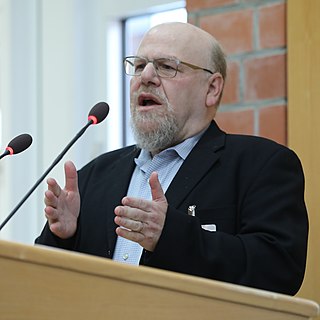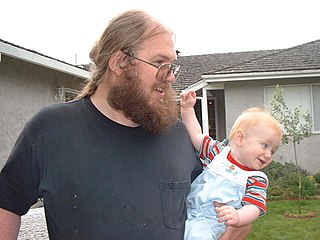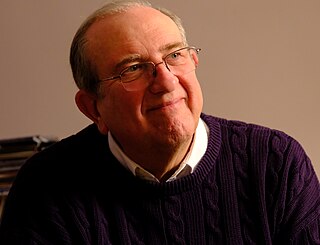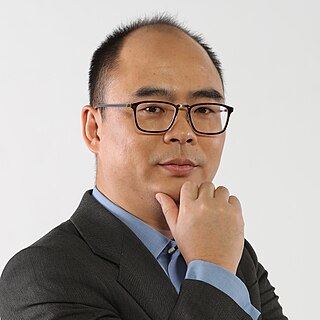Related Research Articles
The Association for Computing Machinery (ACM) is a US-based international learned society for computing. It was founded in 1947 and is the world's largest scientific and educational computing society. The ACM is a non-profit professional membership group, reporting nearly 110,000 student and professional members as of 2022. Its headquarters are in New York City.
Steganography is the practice of representing information within another message or physical object, in such a manner that the presence of the information is not evident to human inspection. In computing/electronic contexts, a computer file, message, image, or video is concealed within another file, message, image, or video. The word steganography comes from Greek steganographia, which combines the words steganós, meaning "covered or concealed", and -graphia meaning "writing".
A digital watermark is a kind of marker covertly embedded in a noise-tolerant signal such as audio, video or image data. It is typically used to identify ownership of the copyright of such signal. "Watermarking" is the process of hiding digital information in a carrier signal; the hidden information should, but does not need to, contain a relation to the carrier signal. Digital watermarks may be used to verify the authenticity or integrity of the carrier signal or to show the identity of its owners. It is prominently used for tracing copyright infringements and for banknote authentication.
Clyde Lee Giles is an American computer scientist and the David Reese Professor at the College of Information Sciences and Technology (IST) at the Pennsylvania State University. He is also Graduate Faculty Professor of Computer Science and Engineering, Courtesy Professor of Supply Chain and Information Systems, and Director of the Intelligent Systems Research Laboratory. He was Interim Associate Dean of Research in the College of IST. He graduated from Oakhaven High School in Memphis, Tennessee. His graduate degrees are from the University of Michigan and the University of Arizona and his undergraduate degrees are from Rhodes College and the University of Tennessee. His PhD is in optical sciences with advisor Harrison H. Barrett. His academic genealogy includes two Nobel laureates, Arnold Sommerfeld and prominent mathematicians.

James Alexander Hendler is an artificial intelligence researcher at Rensselaer Polytechnic Institute, United States, and one of the originators of the Semantic Web. He is a Fellow of the National Academy of Public Administration.

Rosalind Wright Picard is an American scholar and inventor who is Professor of Media Arts and Sciences at MIT, founder and director of the Affective Computing Research Group at the MIT Media Lab, and co-founder of the startups Affectiva and Empatica.

David A. Forsyth is a South-African-born American computer scientist and the Fulton Watson Copp Chair in Computer Science the University of Illinois at Urbana–Champaign.

Stephen Malvern Omohundro is an American computer scientist whose areas of research include Hamiltonian physics, dynamical systems, programming languages, machine learning, machine vision, and the social implications of artificial intelligence. His current work uses rational economics to develop safe and beneficial intelligent technologies for better collaborative modeling, understanding, innovation, and decision making.
Ernest Lenard (Ernie) Hall, PhD, PE, is Professor Emeritus of Mechanical Engineering and Computer Science in the School of Dynamic Systems in the College of Engineering and Applied Science at the University of Cincinnati. He was also the Paul E. Geier Professor of Robotics in the Department of Mechanical Engineering at the University of Cincinnati. He has also held joint appointments at the University of Cincinnati with the Department of Electrical and Computer Engineering and Computer Science. He regularly collaborates with faculty and students in other colleges at University of Cincinnati, as well as civic groups, including the FIRST Lego League, the Ohio Academy of Science, and the Society of Manufacturing Engineers. While consulting with the Oak Ridge National Laboratory, he became interested in efforts to make useful robots for some of the dangerous tasks encountered by the Department of Energy, Department of Defense and NASA. He noted the importance of combining image processing algorithms with manipulators and controller to build intelligent robots, especially in automatic target recognition. He has founded and has co-chaired an annual conference on Intelligent Robots and Computer Vision for the past 25 years to provide a forum for new innovations in this field. He sits as the first Paul. E. Geier Professor of Robotics at the University of Cincinnati. At the University of Cincinnati, he established the Center for Robotics Research, which encourages robotics activities in industry, medicine, defense, and even at home with projects like a robot lawn mower. He also founded the UC Robot Team that has participated in the Intelligent Ground Vehicle Competition for the past 15 years and the DARPA Grand Challenge in 2005 and 2007. He has also served as a judge for the Cincinnati FIRST Lego League for two years and has been called the Woodie Flowers of Cincinnati for giving the Gracious Professionalism award. In 2006, Ernest L. Hall won the Grand Prize in the "Made in Express" contest sponsored by Microsoft. His entry for the contest was an all-terrain self-maneuverable robot developed using Microsoft Visual Studio Express. He donated the $10,000 cash prize from the contest back to the University of Cincinnati to support robotics.

Yann André LeCun is a Turing Award winning French-American computer scientist working primarily in the fields of machine learning, computer vision, mobile robotics and computational neuroscience. He is the Silver Professor of the Courant Institute of Mathematical Sciences at New York University and Vice-President, Chief AI Scientist at Meta.
Mikhail Jibrayil (Mike) Atallah is a Lebanese American computer scientist, a distinguished professor of computer science at Purdue University.
NEC Laboratories America, Inc. , formerly known as NEC Research Institute, is the US-based center for NEC Corporation’s global network of corporate research laboratories. It was established in 1988 with the primary location in Princeton, New Jersey and subsequently, a second location in the San Francisco Bay Area, specifically San Jose, California. The lab is a subsidiary of the NEC Corporation of America, headquartered in Irving, Texas. Its mission is to generate significant new knowledge and create innovative solutions for society in collaboration with industry, academia, and governments. Most research results from NEC Labs America are published in the open scientific literature.

Qiang Yang is the Chair Professor, Department Head of CSE, HKUST in Hong Kong and University New Bright Professor of Engineering and Chair Professor from 2015. He was the founding head of Noah's Ark Lab. He had taught at the University of Waterloo and Simon Fraser University. His research interests are data mining and artificial intelligence.

John Tsotsos is a Canadian Computer Scientist whose research spans the fields of Computer Vision, Human Vision, Robotics, and Artificial Intelligence. He is best known for his work in visual attention, specifically for establishing the need for visual attention in both biological and computational systems through an argument based on the computational complexity of visual information processing and subsequently developing a computational framework for visual attention known as the Selective Tuning model. He is also acknowledged as a pioneer in the area of Active Vision, his students and he being first to propose strategies for active object recognition and object visual search by a robot. He has made many contributions to machine vision (particularly motion interpretation, colour processing, binocular vision, active robotic head design, shape analysis as well as to human vision, robotics and applied areas such as cardiology or dentistry and assistive robotics.

Saraju Mohanty is an Indian-American professor of the Department of Computer Science and Engineering, and the director of the Smart Electronic Systems Laboratory, at the University of North Texas in Denton, Texas. Mohanty received a Glorious India Award – Rich and Famous NRIs of America in 2017 for his contributions to the discipline. Mohanty is a researcher in the areas of "smart electronics for smart cities/villages", "smart healthcare", "application-Specific things for efficient edge computing", and "methodologies for digital and mixed-signal hardware". He has made significant research contributions to security by design (SbD) for electronic systems, hardware-assisted security (HAS) and protection, high-level synthesis of digital signal processing (DSP) hardware, and mixed-signal integrated circuit computer-aided design and electronic design automation. Mohanty has been the editor-in-chief (EiC) of the IEEE Consumer Electronics Magazine during 2016-2021. He has held the Chair of the IEEE Computer Society's Technical Committee on Very Large Scale Integration during 2014-2018. He holds 4 US patents in the areas of his research, and has published 500 research articles and 5 books. He is ranked among top 2% faculty around the world in Computer Science and Engineering discipline as per the standardized citation metric adopted by the Public Library of Science Biology journal.

Demetri Terzopoulos is a Greek-Canadian-American computer scientist and entrepreneur. He is currently a Distinguished Professor and Chancellor's Professor of Computer Science in the Henry Samueli School of Engineering and Applied Science at the University of California, Los Angeles, where he directs the UCLA Computer Graphics & Vision Laboratory.

Talal G. Shamoon is a Silicon Valley executive, computer scientist, entrepreneur, and investor. In 2003 he became the chief executive of Intertrust Technologies Corporation. Starting in 1999, Shamoon has been involved in the development of digital rights management (DRM) technology which was first targeted to copyrights holders such as movie studios, music labels and publishers. He is the chairman of the developer community for the DRM technology Marlin.

Gang Hua is a Chinese-American computer scientist who specializes in the field of computer vision and pattern recognition. He is an IEEE Fellow, IAPR Fellow and ACM Distinguished Scientist. He is a key contributor to Microsoft's Facial Recognition technologies.
A copy detection pattern (CDP) or graphical code is a small random or pseudo-random digital image which is printed on documents, labels or products for counterfeit detection. Authentication is made by scanning the printed CDP using an image scanner or mobile phone camera. It is possible to store additional product-specific data into the CDP that will be decoded during the scanning process. A CDP can also be inserted into a 2D barcode to facilitate smartphone authentication and to connect with traceability data.

Thomas L. Dean is an American computer scientist known for his work in robot planning, probabilistic graphical models, and computational neuroscience. He was one of the first to introduce ideas from operations research and control theory to artificial intelligence. In particular, he introduced the idea of the anytime algorithm and was the first to apply the factored Markov decision process to robotics. He has authored several influential textbooks on artificial intelligence.
References
- ↑ Ingemar Cox, accessed on 25 November 2014
- ↑ "Ansatte". 28 May 2008.
- ↑ http://mediafutures.cs.ucl.ac.uk/people/ Archived 7 March 2013 at the Wayback Machine Accessed On 15 May
- ↑ Archived 31 December 2013 at the Wayback Machine , accessed on 15 May
- ↑ Signafy, Inc.
- ↑ Galaxy
- 1 2 Cox, Ingemar et al., Digital Watermarking and Steganography, Morgan Kaufmann, 2007, p. 591.
- ↑ http://www.ieee.org/membership_services/membership/fellows/alphabetical/cfellows.html#Co Archived 2013-11-02 at the Wayback Machine Accessed On 15 May
- ↑ ACM Names Fellows for Computing Advances that Are Transforming Science and Society Archived 2014-07-22 at the Wayback Machine , Association for Computing Machinery, accessed 2013-12-10.
- ↑ Ingemar J. Cox, Digital watermarking. Morgan Kaufmann, 2002
- ↑ Ingemar J. Cox, Digital watermarking and steganography. Morgan Kaufmann, 2007
- ↑ Ingemar J. Cox and Gordon Wilfong, eds, Autonomous Robots Vehicles, Springer-Verlag Berlin and Heidelberg GmbH & Co. K (Aug 1990)
- ↑ Ingemar J. Cox, B. Julesz and P. Hansen, eds, Partitioning Data Sets, American Mathematical Society, 30 March 1995.
- ↑ "The Strix Award: in honour of Tony Kent's life and achievements". Chartered Institute of Library and Information Professionals. Retrieved 16 June 2021.
- 1 2 "Ingemar J. Cox". scholar.google.com. Retrieved 20 October 2020.
- ↑ http://patent.ipexl.com/inventor/Ingemar_J_Cox_1.html Accessed On 15 May